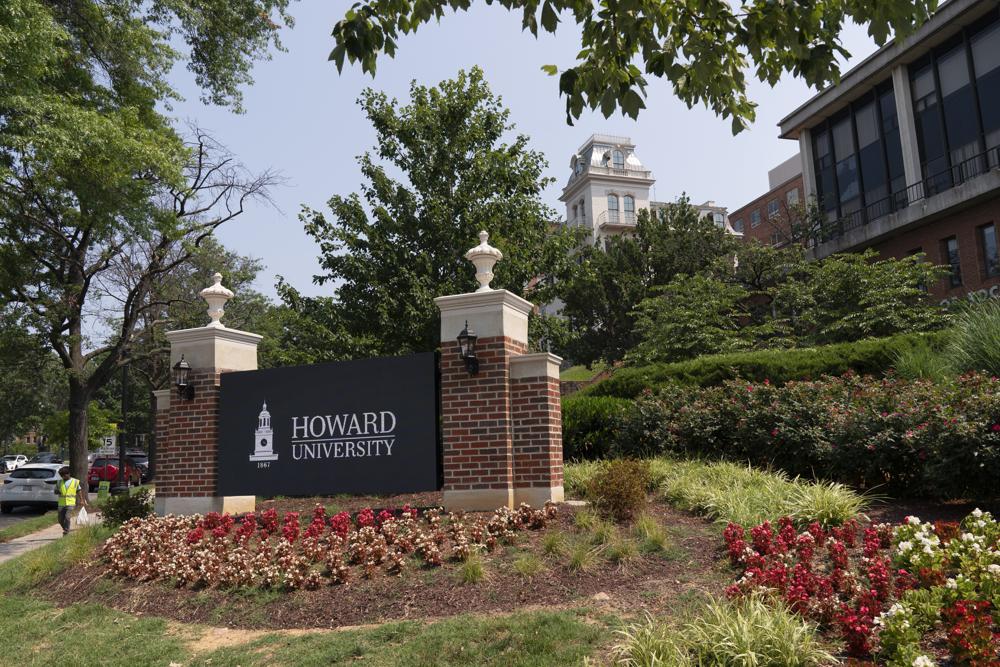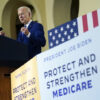FILE – In this July 6, 2021, file photo, an electronic signboard welcomes people to the Howard University campus in Washington. Two high-profile faculty appointments this week could be a fundraising and enrollment bonanza for Howard University, one of the nation’s most prestigious Black colleges. (AP Photo/Jacquelyn Martin, File)
ATLANTA (AP) — Two recent high-profile faculty appointments could be a fundraising and enrollment bonanza for Howard University, one of the nation’s most prestigious Black colleges. Many other Black schools are not so fortunate; in fact, many are struggling.
Some, especially smaller private colleges, have been fighting for their survival for years, with weak endowments, aging buildings and steady enrollment declines, all made worse by the coronavirus pandemic.
“While larger HBCUs often have the funding resources necessary to attract accomplished talent like Nikole Hannah-Jones and Ta-Nehisi Coates, many smaller institutions need donors to step forward, contributing much-needed financial resources for us to compete,” said Dr. Paulette Dillard, president of Shaw University, a private Black university in Raleigh, North Carolina.
Hannah-Jones accepted a faculty position at Howard amid controversy over whether she would be granted tenure at the University of North Carolina after critics questioned her credentials, specifically her Pulitzer Prize-winning work “The 1619 Project,” which traces the country’s history with slavery. Coates, a Howard graduate, is a journalist and best-selling author who also recently joined Howard’s faculty.
Billions of dollars in federal virus relief will help higher education, but it may not be enough to change the long-term fortunes of some historically Black schools. An Associated Press analysis of enrollment and endowment data shows wide disparities among 102 historically Black colleges and universities, and a further divide between private and public institutions.
As one example, the five wealthiest private Black colleges had endowments ranging from $73,000 per student to more than $200,000, far above the median endowment of less than $16,000 per student. The largest endowment for a public Black college was less than $25,000 per student, though the public schools also receive state aid.
Overall enrollment in historically Black colleges has declined 11% in the most recent 10-year period for which data is available, from 325,609 in 2010 to 289,507 in 2019. Enrollment at some campuses dropped by half during that span, and several administrators said enrollments dropped further during the coronavirus pandemic last year.
As a rule, Black colleges also haven’t had the fundraising ability of other universities. The cumulative endowment for all historical Black colleges through 2019 was a little more than $3.9 billion. That’s about equal to the endowment for the University of Minnesota alone.
Of that amount, just eight private Black colleges held 54% of the total: Spelman College, Hampton University, Meharry Medical College, Xavier University of Louisiana, Morehouse College, Tuskegee University, the Morehouse School of Medicine and Howard, which counts Vice President Kamala Harris among its graduates.
Last summer’s protests over racial injustice brought renewed attention to historically Black colleges and universities and led to a surge in private donations, at least for some.
Mackenzie Scott, the ex-wife of former Amazon founder Jeff Bezos, gave $560 million to 22 Black colleges, including some with very limited endowments, as well as to the Thurgood Marshall College Fund and the United Negro College Fund, both of which raise money for Black colleges and universities. Netflix founder Reed Hastings and his wife, Patty Quillin, split $120 million among the United Negro College Fund, Spelman and Morehouse. Former New York mayor and entrepreneur Michael Bloomberg pledged $100 million for student aid at the four historically Black medical schools.
“It’s allowing the schools to see the opportunity to be bigger than they previously thought was possible,” said Harry Williams, president and chief executive of the Thurgood Marshall fund.
Yet many lesser-known schools continue to struggle and scrape for money. Shaw, one of the oldest historically Black colleges in the South, has an endowment worth just $8,436 per student and did not benefit significantly from the wave of private giving last year, said David Byrd, the college’s vice president of finance.
The college is able to “pay the bills” and get by, he said, but still has $26 million in deferred maintenance. Shaw and other smaller Black colleges that mostly depend on tuition are counting on help from the federal coronavirus relief championed by President Joe Biden and passed by Congress this spring. That aid package will send roughly $2.6 billion to historically Black colleges, although the U.S. Department of Education has not yet announced how it will allocate the money.
Shaw plans to use the money to fix older buildings and dormitories and expand a variety of student services. The federal aid can be used to make up for lost tuition income during the pandemic, hire more faculty, offer pay raises and upgrade heating and air-conditioning systems.
Wilberforce University in Ohio, another small historically Black private college, plans to use its pandemic relief money in similar ways, after the government forgave much of the university’s $25 million in federal debt.
“The bottom line: It’s very beneficial to the faculty, staff and students at this university, because now we have some additional opportunities for support,” said William Woodson, Wilberforce’s financial vice president.
Student debt is a significant drag on graduates of historically Black colleges, and administrators say it hurts enrollment. Limited endowments mean their campuses can’t subsidize tuition as much as wealthier colleges.
A large percentage of students enrolled at historically Black colleges come from the poorest families, those making $20,000 a year or less, which forces them to borrow. Federal figures show the typical Black college graduate who borrowed money owes $52,000 in student loan debt, roughly double what the typical white student owes.
In addition to giving more financial aid to students, many Black colleges are considering using their federal pandemic money to create campus work-study jobs through which students can earn income, provide subsidized child care, buy personal computers and help students pay for high-speed internet connections.
At Shaw, officials hope renewed national interest in historically Black colleges and the role they play could spark enthusiasm for schools with much smaller endowments that have had to choose between updating buildings, closing programs or keeping tuition affordable for their students.
More than 80% of Shaw’s undergraduates are eligible for federal Pell Grants, compared to roughly 45% of Howard students. But Byrd, the school’s financial officer, said that’s also where the university has had an impact for the past century and a half: giving low-income students the tools to find a career and succeed.
He said it’s “really tough to predict” how long it will take for the university to recover from the pandemic. Its finances are primarily driven by tuition and donations, yet enrollment has dropped by nearly 53% from 2010 to 2019. He cited the need for continued federal relief or private donations that trickle down to the smaller schools.
“People think we want a handout for nothing. We have a proven track record for producing a certain type of kid for 150 years,” Byrd said. “So, it’s not really a handout; it’s an investment.”
Hudspeth Blackburn reported from Louisville, Kentucky. Fenn reported from New York.
Hudspeth Blackburn is a corps member for the Associated Press/Report for America Statehouse News Initiative. Report for America is a nonprofit national service program that places journalists in local newsrooms to report on undercovered issues.
Copyright 2020 Associated Press. All rights reserved.









































